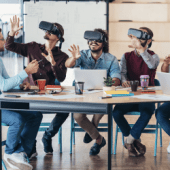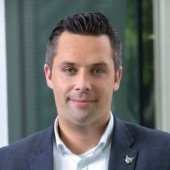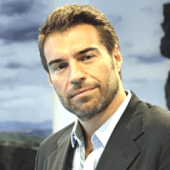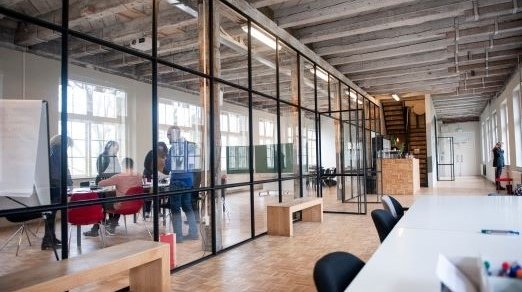Listen up! The future of workforces and workplaces
IN BRIEF
- 3:57 - When we’ve put ourselves to the test as we have had to do over the past two years, businesses have been pretty good and very able at coming up with better ways of doing things and doing them quickly.
- 20:32 - If companies continue to think about the challenge in these terms and focus on where people are on given days, I think they’ll overlook a much bigger opportunity and that’s to fundamentally rethink, rebuild, reimagine the way their business operates and where it operates.
- 25:25 - I think those work environments will be effectively zoned. I look on these zones as being more like film sets or film studios, and each one will have a different script, will have a different technology usage, will have different scenery… We talk about the office. I think there’ll be many more hybrid office locations, maybe even pop-up locations that we use specifically for specific purposes. There’s a huge amount of change to come there.
Joe Kornik, Editor-in-Chief of VISION by Protiviti, chats with Peter Richardson, Managing Director and Architect for the Future of Work at Protiviti. Richardson leads the firm’s focus on the future of work globally where he emphasizes rebuilding the operating model and future of work engine by empowering teams, equipping them to contribute fully in a hybrid environment and developing and underpinning culture. The two discuss the future of work as it relates to culture, collaboration, and location for knowledge workers.
LISTEN UP! THE FUTURE OF WORKFORCES AND WORKPLACES - Podcast transcript
Joe Kornik: Welcome to the VISION by Protiviti podcast. I’m Joe Kornik, director of brand publishing and editor-in-chief of VISION by Protiviti, where we put megatrends under the microscope and look into the future to examine the strategic implications of the topics that will impact the C-suite and executive boardrooms worldwide.
Today, we’re exploring the future of work, and I’m happy to be joined by my Protiviti colleague, Peter Richardson, managing director and architect for the future of work at Protiviti. Peter leads the firm’s focus on the future of work globally, where he emphasizes rebuilding the operating model and future-of-work engine by empowering teams, equipping them to contribute fully in a hybrid environment, and developing and underpinning culture. Today, we’re going to discuss the future of work as it relates to culture, collaboration and location for knowledge workers. Peter, it’s so great to have you with me on the podcast today.
Peter Richardson: It’s great to be here too, Joe. Thanks very much and thanks for the opportunity to discuss this topic, which is very close to my heart.
Joe Kornik: I’m looking forward to it. Peter, as much as I thought that by March 2022 we would be able to be well past the pandemic, it looks like we’re not quite there yet, but I do think it’s pretty safe to say these last two years have had a pretty profound impact on those three things I just mentioned above: culture, collaboration and office locations. We’ll take them one at a time, but before we do, I’m wondering if you could share any thoughts you have on what the last two years have meant in terms of the future of work and what impact, ultimately, you think it’ll have over the next decade of work.
Peter Richardson: Let me say, first of all, I’m going to talk primarily about office-based workers or knowledge workers. My role doesn’t focus that much on manufacturing, retail or other forms of physical delivery, so I’m talking about work that’s not really site-based or particularly equipment-based. The pendulum has swung significantly toward a way of working that we’ve, to be blunt, never seen before. Work is no longer just somewhere we go. It’s something we do and can do everywhere, and we’ve proven that.
That trend has accelerated pretty rapidly over the last two years, and as you say, Joe, there are three major areas where things have changed most significantly. Ever-evolving remote collaboration has been enabled by technology and is changing the way we work, but it’s got potential to go much further in redefining work in a hybrid world that we’re now beginning to inhabit much more fully. Organizations have been keen and remain keen, of course, to protect and enhance their cultures, but what people have experienced over the last 18 months has engendered some significant and more permanent changes in the way people think and behave and interact within their ever-changing organizations.
The spaces that we once called offices are beginning to look and feel very different, so a better world of work is waiting. Now, why do I say that? We used to look at our businesses in a pretty rigid way. It was based on a certain way we work. It was more on a manufacturing model where people worked in fixed locations close to where they lived. They got up at the same time every day. They stayed in the same place to do the stuff we needed them to do. It was an old-world paradigm based on pre-mobile phone and pre-internet operating models — people in the office all the time, people 100% getting up early, people pretty much 100% commuting, pretty much 100% physical presence for management oversight and probably control.
When you think about it, that model had become already pretty outdated, but what we’ve learned over the past 24 months now, as you say, is about the irrelevance of much of that. When we’ve put ourselves to the test, as we have had to do over the past two years, businesses have been pretty good and very able at coming up with better ways of doing things, and doing them quickly.
There was some McKinsey research that asked CEOs about 12 potential changes and how long it took them to execute before and during the crisis, and for many of these changes, respondents said that their companies acted as much as 20 to 25 times faster than they had expected. In the case of remote working, the respondents, the CEOs, said that their companies had moved 40 times more quickly than they thought could be possible before the pandemic. Before the pandemic, executives said it would take more than a year to implement the level of remote working that took place during the crisis, and it took an average of 11 days to implement a workable remote-working solution, but we’re still learning and experimenting with how to deal with some of the paradoxes that have also been created over that time. There’s a question of remote versus in-person time.
Microsoft commissioned some research that concluded that — you have heard numbers like this before — 70% of workers want flexible remote-work options to continue, while at the same time, the paradox is that 50%, 60%, 65% have been craving more in-person time with their teams. Then, there’s a question of, are we more effective and more efficient now? And as a counter to that, what’s been the impact on fatigue and exhaustion? I’ve read some numbers from Unilever, which reported that for their office-based workforce, they had seen an increase of 22% in productivity, 30% in collaboration and 19% in external orientation from those office-based workers.
At the same time, if you look at other numbers, it’s actually the older workers and bosses who are identified as thriving, where the satisfaction index there is about 60%. Whereas, for those without decision-making authority, the satisfaction index is about 35%. And then, if you look at Gen Zers, those aged between 18 and 25, the consensus is that they’ve been struggling more to balance work with life, and they’re more exhausted than their counterparts. They’re not as excited, not as engaged about work, can’t get a word in during some meetings or bring new ideas to the table, and they’re yearning for much more in-person interaction, so there’s a lot going on there.
When you look at office space, office usage, businesses are talking about 30% lower office footprint, lower office usage, still struggling with the question of work from home versus should people be spending a certain percentage of their time in the office? Should we be enabling working from anywhere? When it comes to that, some leaders are still saying — somewhat ill-advisedly — “Let’s get back to the former reality.” “Let’s drop this,” as one leading CEO said, “aberration of remote working,” and others, equally ill-advisedly, are saying, “You will work in the office for three days a week.”
I would advocate specific use cases for bringing people together in-person as the way forward, and I’m sure we’ll come onto that later in the discussion. Looking at it in the round, the last two years have been a tipping point of historic proportions. That’s not to overestimate things. The pace of change is probably likely to slow down for now, but looking forward, more changes will still be required as the economic and human situations evolve.
Remote work has created an opportunity to bring in at pace — significant pace — digital transformation to fruition where many companies have been stuck in pilot mode for years, has created new job opportunities for some, has offered more family time and a better work-life balance for some but not all. There’ve clearly been some who have lost out, and I acknowledge that. It’s provided options for whether or when to commute or not to commute at all, but there are also real challenges ahead. Teams have probably become, over the course of things, somewhat more siloed.
Digital exhaustion is a real challenge, and it will be critical to learn and experiment going forward with how to use technologies to execute a delivery more effectively to change organization operating models, to change at a pace that continues to exceed prior performance, and to address, again, as you’ve alluded to, Joe, the cultural and people implications to focus on new capabilities in people — not just those designed for the crisis but also including digital fluency, data literacy and agile ways of working. In summary, overall, we’ve learned an awful lot and probably surprised ourselves equally with an awful lot too.
Joe Kornik: That’s spot-on. So much has come out of the last two years, but to your point, there is no going back. To try to reinvent the way we worked in 2016, it’s just a losing proposition. Peter, I’m old enough to remember when every phone call didn’t last 30 minutes, though, so we do need to find a happy medium where we used to just call our mate and talk for six minutes and hang the phone up because we were done. It doesn’t happen as much in this new environment, this environment that we’re in today.
You’ve brought up culture, and I feel like that’s a good place to go, to take this conversation next. I’m always fascinated by it. It’s such a tricky thing, because it means very different things to everyone, to very different people. A lot of companies build their brand on culture. It’s one of the differentiators. It’s one of the things that they talk about when they recruit employees, their culture. That’s all been shot in a cannon up into the sky, and we’re going to have to see where it all lands.
Employers, obviously, view it differently than employees. Employees view it differently from each other. For some, it’s all about the office and that interaction and that collaboration in person. For others, it might be all about no office or lack of office, and that’s great culture to them. That’s the way they want to work. Let’s start with employees. We’re going to look at this from both sides, but we’ll start with the employees’ perspective.
Peter Richardson: For me, culture is about survival. It’s about what individuals need to do to fit in and thrive within an organization, and that doesn’t come so much from the physical aspect. It comes from the behavioral ones. The basic underlying assumptions about what’s right and what works within this organization, that’s what drives the way people then behave within the culture, within that organization. Everyone within an organization experiences the effects of culture every day.
Culture manifests itself, of course, in a number of ways, but what you see, hear and feel isn’t always an accurate reflection of the true drivers of the culture in that organization. It’s made up of a number of levels. Starting at the top of what you might imagine as a pyramid are the artifacts. This is what people can see, touch — the physical aspects — and includes things like policies, procedures, mission statements and so on, but it can also include things such as office locations, buildings, who gets what desk on what floor. All of these physical and visible aspects of the organization environment convey messages about the way things are done.
At the next level down in the pyramid, underneath the artifacts, sit what Edgar Schein would call the espoused beliefs and values. This is what you hear as you move around in organization, what people say, how they interact with each other and what they do on the surface. Sometimes, what people say is genuine, but you may also find that those statements at that level could be examples of toeing the company line. And sitting underneath all of that, this is where the culture really manifests itself and what drives the organization’s culture. Sitting under that are the basic underlying assumptions within those individuals and organizations that drive the way they behave when no one’s watching.
What’s interesting is, as we go down through those layers, from artifacts through espoused values into values and then into behaviors, what’s most visible and out in the open reduces, whereas the conclusiveness, the impact, about what drives the organizational culture increases. I argue that, yes, on the basis of all that, as a consequence of what’s been going on over the past two years, cultures will have changed.
At the moment, given the extent of change over the past 18 months, it feels to me sometimes like we’re on a different planet. We’re almost on Mars and not on planet Earth. The environment is fundamentally different. Engagement is different. People are behaving in a different way. In many cases, they almost speak a different language about work. The atmosphere sometimes makes it difficult to think clearly, and the terrain ahead is not fully mapped out and understood.
Why do I say that? If you look at pre-pandemic, as I described in my opening comments, we lived in a well-defined world where people came together into offices, into the atmosphere that was very physical pretty much every day. In the remote working world of the pandemic, people have experienced an entirely different working paradigm, an entirely different skew to their work-life balance. Certainly, since children have been back in school, there’s been less onus on parents to participate as directly in their children’s education, and probably, quite strongly, a positive work-life balance.
If you ask leaders, as I do regularly, which paradigm they most support going forward, some argue that it’s option one — that we go back together again to rekindle our cultures and values is key to them — and others argue that maintaining alignment with this new agile and flexible paradigm supporting flexibility and recognizing work-life balance is the only way to retain and attract talent, which is becoming an increasingly significant challenge and, again, a topic we may come to later, Joe.
The fact is that both sets of people, both paradigms, both are right. The conclusion I draw from that is that in order to satisfy both constituencies, an entirely new paradigm that’s neither based on option one nor option two is the answer, and that still has to be fully designed. In the meantime, there’ll be a lot of experimentation and agility required as new hybrid operating cultures and operating models are tried and tested — so, a lot of change ahead.
Joe Kornik: When you look out over the next decade, I’ve been hearing about a talent shortage, particularly in Europe and North America. How worried should executives be about that, and having the skills and the capabilities and the people to get all the work done that they’ll need to in, let’s say, 2030 and beyond?
Peter Richardson: There are, as I’ve touched upon, some quite complex people and behavioral issues to deal with here, and this world doesn’t suit everyone. There’ve been, of course, losers in the way that things have operated in the last couple of years. I spoke on those pressures, but in particular, there’ve been pressures on women with children, on younger and newer employees. In order to continue to be able to attract and retain those people, organizations do need to look long and hard at the way they approach talent and the retention of their people.
I’d also like to touch upon a couple of ideas — in particular, the threat of how a two-tier system might develop, and what we need to do to avoid that. A lot of articles published in this area argue that people who come into the office will be able to advance more quickly and catch the eye of their managers more easily, and at the same time, those who choose to work more at home are somehow going to lose out from not being there in person, and these are very real concerns.
They’ve been shared privately in many of the events we’ve run and amongst some of our clients, and some businesses are being tentative in their approaches here, while others are making it very clear that being in the office will create opportunities. That’s mistaken and will potentially cause issues as far as the retention of key people is concerned. I do appreciate that there’s a risk of presenteeism coming back, but it’s important that we create a much more inclusive working model in the new models we implement.
Companies can use technology, physical locations and remote locations to ensure that people remain connected, and we can’t assume that all managers will go back into the office either, so let’s define the reasons for people being in the office. If what they’re doing doesn’t require them to be there, then why force them to be there? Why try and use that short shoe on to push people into those locations?
In our business, we’re asking ourselves questions like, “Is this something that people need to be with co-workers to do, or not?” If it isn’t, then it doesn’t make sense, necessarily, for them to be forced to be in a physical location to do it, and let’s try also to understand people’s motivations for social interaction and human connection. People want to be together for so much of their social life. It’s perceived that being in the office and being with their colleagues and friends is what it’s about. People aren’t actually yearning to be in the office, though. They’re yearning for that social interaction, so let’s make sure that we’re addressing that question rather than looking at it from a physical-location point of view, especially if people have got commutes, fixed hours that don’t suit them, or if they’re looking after families and parents.
Now, that’s what they’ve experienced much of over the past two years. That’s where they’ve experienced so much more value above and beyond being physically in an office together, and we need to be able to respond to that in order to make sure that we are able to respond to our people’s needs.
Joe Kornik: Let’s just keep going down that road to the office, because I feel like this is one of the more fascinating things that will develop over the next decade, around what the office of 2030 will look like.
Peter Richardson: It’s interesting, isn’t it? As you’ve just said that, Joe, there’s been a lot of talk about people “going back to the office.” Again, as I’ve said before, some leaders have made it clear that they want people to return, while others are much more active in exploring hybrid models between an office and other physical locations, and still more are confused. People talk about that the office is work rather than a place to go and work, and there’s a big difference. If companies continue to think about the challenge in these terms and focus on where people are on given days, they’ll overlook a much bigger opportunity, and that’s to fundamentally rethink, rebuild and reimagine the way their business operates and where it operates. That ranges from where people work to how they work to what work means through to things like their carbon footprint.
We need to start talking much more about how we involve, include and engage our people wherever they’re located, so our physical locations need to be equipped and designed to achieve that wherever our people are, whether they’re working from home or not. Let me be clear: I’m not talking about a world where people stay permanently out of the office. I’m talking about a world where we’re smart about the reasons for bringing people together.
The old Industrial Revolution-driven office environment is entirely about having people in front of you, and this raises issues about trust. I’m arguing that that’s a completely outdated model, and I can’t understand why people feel that going back to that is beneficial. Demanding that employees come into the office five days a week or three days a week or whatever it happens to be to do what they used to do will create a backlash. Asking employees to come into the office once five days a week from to time to do things that are valuable is a redesign of the way we work, and that’s fundamentally the point that people really need to consider deeply.
I consider that mainly in terms of person activity. The question is, how do we get the most value out of assets that will become scarcer over time and the most value out of in-person activity for our clients, for our people and for our business, and what are the use cases that most require or demand or benefit from in-person activity?
The best definition I heard on this topic was in the relatively early days of the pandemic, when a senior person in marketing in a major confectionary firm talked about, as she termed it, the five C’s, and she used these words: connectivity, collaboration, creativity, celebration and compassion. They were the five strong rationales, as she put it, for needing people in person together.
I’ll add a couple more: culture — things like how we introduce people to the business, how we induct people, how we train people, etc., and possibly something specifically to do with client engagement, although that could equally be probably covered under the term connectivity, but something that specifically focuses on in-person connectivity, relationship building with clients. I agree with that list, and businesses will increasingly bring people together for in-person interaction only when they actually need to, because it’s the right thing to do.
I’m remembering, too, that these use cases need to work for all types of in-person interaction, ranging from when it’s 100% physical, so we have everyone together in one meeting, through to some physical and some virtual for your people and your clients where there’s a good degree of in-person presence in a physical location and a degree of remote presence too — a true hybrid model.
We’re still really learning how the make this work in practice. Remember that I referred to living on a different planet? We need to equip our people wherever they may be to be able to facilitate and manage these types of interaction in an entirely different way, and that doesn’t just mean by providing technology support. It means by training them, developing them, enabling them with new soft skills around facilitation, around client management, around presentation. My job these days seems much more like being a television presenter than in my world, a consultant who visits my clients every day, so I need new skills to be able to do that in the new world in which we’re expected to operate.
Looking further forward, those work environments will be effectively zoned along the lines of those five, six, or seven C’s I mentioned. I look on these zones as being more like film sets or film studios, so the collaboration studio — call it studio one, for example — will be fundamentally different from the creativity or the compassion studio. We’ll call them studios two and three. And each one will have a different script, will have a different technology usage, will have different scenery, will have potentially different costumes, wear different clothes. The direction of the activity in those studios will be different. The production will be different. The locations may be different. We talk about the office. There’ll be many more hybrid office locations, maybe even pop-up locations that we use specifically for specific purposes. There’s a huge amount of change to come there, Joe.
Joe Kornik: Yes, it sounds like it. What an interesting look at the future of the office space. You mentioned how often you are in front of clients, talking about these very same things. I’m wondering if you could boil it down to a few succinct calls to action for business leaders. It’s no secret that we’re facing a tumultuous future of work. We can all agree on that. What do you tell them to make sure that they get that right?
Peter Richardson: I look at it in terms of barriers that need to be overcome: There are a bunch of barriers that will get in the way of creating that new vision and making things happen. There’s a real momentum to refine and redefine the way business is done, but there are some significant challenges. One is, let’s be honest, that many business leaders are grounded in that old paradigm and find it difficult to imagine a way of working that’s fundamentally different. I respond by saying, “Well, what are the consequences of not doing anything?” We’re already seeing companies experiencing highly unusual levels of attrition, people leaving. That is as a consequence of not having answers for those people, including parents with children, millennials, Generation Zs, who are looking for smarter answers. If they don’t get them from our business leaders, then they’ll move on.
Another barrier is a clear communication about what’s next, which is linked to the point I’ve just made above: Most organizations have been good at communicating and engaging strongly with people in the current environment, but as they start to tackle the challenges looking forward, they’ll need to maintain or find a new level of engagement and connectivity that’s about the future, that’s about looking forward. Now is the time to push again, to push harder, and it’s going to require the same level of commitment, involvement and drive as it did during the beginning of the pandemic, when we were worried about communicating with our people and keeping them engaged.
Trust is still an issue that is linked to a model of working that’s essentially based on seeing people and monitoring them, and we have to acknowledge that what we’ve proven and seen in the last 18 months in many businesses is that we should trust people. It’s worked really well in many instances, and what evidence exists to prove widespread failure and bad behavior of people working in this remote world, I don’t think there is much. It’s proven the opposite. There’s more trust now, and we’re more able to be able to rely on our people working in an agile and flexible way that isn’t always under our noses.
There’s a fear of changing the working model that’s familiar, especially when solutions are going to be experimental, and I respond to that that some companies have implemented change programs between 20 and 40 times as quickly as they have done before, as that McKinsey research showed. It’s been an accelerator that’s applied here, and it’s proved that many things are possible that we often feared and prevented ourselves from being able to do before because of legacy concerns. We can’t just take that foot off that pedal now. There’s a danger that I’ll start driving in a slower lane, and if too many companies do that, the bigger opportunity will be lost.
Joe Kornik: Before I let you go, I’d like to ask people to live the VISION by Protiviti mantra one more time and to look out, let’s say, to 2035. Let’s go 13 years in the future and put yourself into that time frame. Any bold predictions about the future of work? What aren’t we considering? What may surprise us about how or where we’ll work in 2035? Have you got any bold predictions for us to share before we wrap up?
Peter Richardson: It’s a long time ahead, Joe, but I’ll try my best. We have this huge opportunity to continue to redefine what work is, what meetings are. We’ve only scratched the surface so far. Our application of the technology so far has been really to apply new technology over old operating models, old processes. We’ve run meetings, the same old meetings we always used to run. We just run them with video. I don’t think we’ve exploited the potential for fundamentally redefining what a meeting is, how we work, where we work, what we do it for at all.
The technology infrastructure is there now to deliver much more remotely, but also that means that we won’t need to go on planes and trains and run around the country as much as we used to do, especially in the context of the ever more important ESG agenda. Just think what the opportunity is in terms of carbon footprint if we continue not to travel to the extent we did.
Now, I know that’s not great for the travel industry, but certainly in terms of people in my industry, it creates a significant new paradigm. There’ll be fundamental changes to the employee value proposition, the employee experience. Cultures will be different. Leadership engagement will need to be different. Working conditions will be different. The opportunity for diversity, equity and inclusion will be different because we can employ people and include people and engage people from much broader environments and backgrounds and locations. Remuneration and progression will probably be different as a consequence of all of that.
The pathfinder, the leading organizations have already recognized that no one actually has the right answer, and they will continue to lead the way based on data and workplace analytics and surveys of staff and of clients. Those organizations, over the next many years, will be prepared to continue to test, review, experiment and throw away if it doesn’t work.
There’s a lot of change ahead, and that’s really exciting. As well as the physical experience and logistics of the workplace environment, there’ll need to be changes in policies in issues such as tax and legal; changes to contracts and employment policies that will all impact the employee experience and will need testing with new workforces; how people get access to their leadership; further opportunities for skills development, digital skills requirements; personal and travel time; and how we will recruit. There is a lot of change ahead, Joe. That’s a bit of a broad answer, but there’s an awful a lot of opportunity over certainly the next 10 years–plus.
Joe Kornik: Absolutely, and we will be here to chronicle it every step of the way. Thank you, Peter, so much for your time today and your insights. It was wonderful having you on the show.
Peter Richardson: Thank you, Joe. I’ve enjoyed it.
Joe Kornik: Thank you, at home, for listening to today’s podcast. Please rate and subscribe wherever you listen to podcasts. Please do check us out at Vision.Protiviti.com or on LinkedIn at VISION by Protiviti. Thank you, and we’ll see you next time on the VISION by Protiviti podcast. Take care.
Peter Richardson is Managing Director and Architect for the Future of Work at Protiviti. Richardson leads Protiviti’s focus on the future of work globally. In helping clients face the future with confidence in an ever more dynamic world, he emphasizes rebuilding the operating model and future of work engine by empowering teams, equipping them to contribute fully in a hybrid environment and developing an underpinning culture. Richardson is a specialist in change management and operational transformation.
Did you enjoy this content? For more like this, subscribe to the VISION by Protiviti newsletter.






























